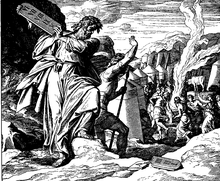| Part of a series on the |
| Ten Commandments |
|---|
 |
| Related articles |

"Finger of God" (Hebrew: אצבע אלהים ’etsba‘ ’Ĕlōhîm) is a phrase used in the Torah, translated into the Christian Bible. In Exodus 8:16–20 it is used during the plagues of Egypt by Pharaoh's magicians.[1] In Exodus 31:18 and Deuteronomy 9:10 it refers to the method by which the Ten Commandments were written on tablets of stone that were brought down from Mount Sinai by Moses.[2]
It was also used once by Jesus in the Gospel of Luke to describe how he had cast out demons.[3]
Jews in the tradition of Maimonides posit that anthropomorphism in the Torah, such as the use of body part names, is completely metaphorical, as human bodies are based on potencies of God, not the other way around.[4]
The Finger of God is a phrase used in the Pentateuch or the Five Books of Moses, specifically in the Book of Exodus, to describe an expression of God's power and authority. In Exodus 8:19, Pharaoah's magicians acknowledge the plagues as the finger of God, referring to the harsh natural phenomena that God has brought upon Egypt. The term is also mentioned in Exodus 31:18, where it is said that God wrote the Ten Commandments on tablets of stone with his own finger.
The phrase "finger of God" is used to symbolize the power and might of God and is commonly interpreted by scholars as a sign of His divine intervention and the manifestation of His will. In the New Testament, it is also used metaphorically in reference to Christ's healing power (Luke 11:20). Overall, the Finger of God is a biblical expression that signifies the authority and power of God in the world.
- ^ Exodus 8:16–20
- ^ Exodus 31:18, Deuteronomy 9:10
- ^ Luke 11:20
- ^ Abramowitz, Rabbi Jack (26 March 2018). "Anthropomorphism of God in the Torah".
© MMXXIII Rich X Search. We shall prevail. All rights reserved. Rich X Search
